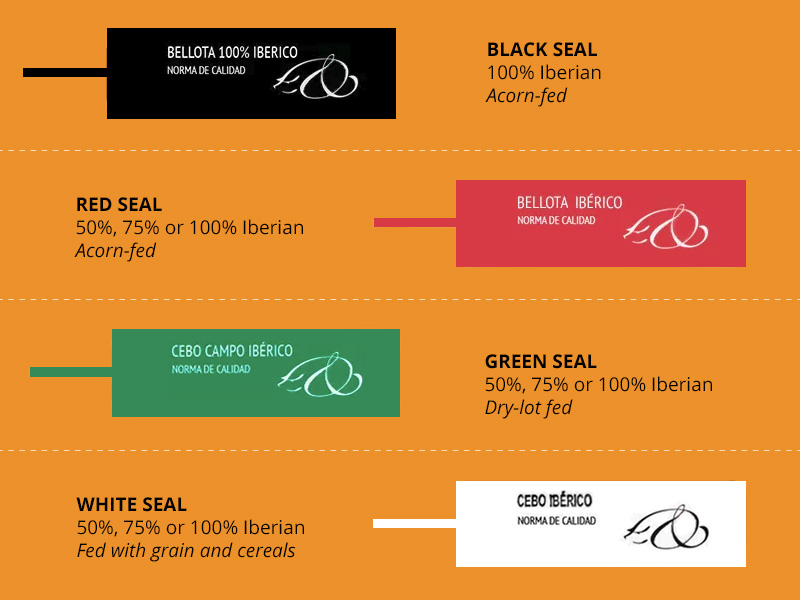
In January 2014, Royal Decree 4/2014 came into force, approving the quality standard for meat, ham, shoulder and shank from Iberian pork. From this date onwards, all hams on the market labelled as Iberian should meet this standard that categorises pieces depending on two parameters: animal feed and racial purity.
When these hams reach the market, in addition to the correct commercial labelling (the label or band that each brand uses), it should have a seal around the leg that matches its sales description.
There are two types of seal: seals awarded by the Inter-professional Iberian Pig Association (ASICI), for hams that meet the RD 4/2014, and seals for hams covered by one of the four PDO for Iberian ham in Spain, quality standards covered by the European Union that validate the RD 4/2014 and also set stricter standards for breeding pigs and producing the pieces.
Four hams, four colours
The black seal refers to hams and shoulders that come from 100% Iberian pigs fed an extensive diet. In their fattening stage, they are fed on acorns, roots, grass and pasture on the mountain plain. Its specific designation must be: 100% Iberian Acorn-fed Ham (or Shoulder). This is the only one that can be called Pata Negra.
The red seal is reserved for pork products that have been fed with acorns on the high plains, like the black seal, and are crossed with Duroc pigs. This crossing can be done in one of two ways. If the father is Duroc and the mother is Iberian, then the pigs are 50% crossed. In turn, if one of these crossed males is paired up again with an Iberian female, the result will be a 75% pig (although the genetics are not mathematical). Both crosses use the red seal. However, if they are certified as such, this percentage can be reflected on the commercial label, with the following denominations: 75% Iberian Acorn-fed Ham or 50% Iberian Acorn-fed Ham.
The green seal differentiates dry-lot feeding. It refers to hams and shoulders from pigs that might have been bred extensively or in intensive outdoor facilities with a covered area. Their feed is mainly based on fodder grain and grass from the fields. However, some hams have reached the market from pigs that have eaten acorns, although not enough to be marked as such, and they remain classified as dry-lot fed. What actually happens is that the immense majority of the green seals on the market come from pigs bred intensively (100 m² per animal), fundamentally grain-fed. The same happens with their racial purity. Although the standard covers both Iberian pigs and crossed pigs (from 50% to 75%), the later usually dominate the market. Their commercial name would be as follows: 100% or 75% or 50% Iberian Dry-lot fed Ham. If you want to know more about this type of ham and the ambiguity of a standard that is used for hams that come from very different places, we recommend this wonderful Jamón Lovers post.
The white seal is far and away the most commonly found on sale. Just like the green seal, its racial purity might be 100%, 75% or 50%. However, as we saw with the dry-lot feeding, it is extremely rare to find white seals for hams from pigs that are 50% crossed. In this case, the pigs are bred in intensive farms and their food is based on grains composed of cereals, pulses and fats. The name that should appear on its commercial label is 100% or 75% or 50% Iberian Grain-fed Ham.
Four DOP, three colours
As we mentioned above, the Protected Designations of Origin are quality standards covered by the European Union that validate the national Iberian standard. Both the ASICI seals and the different DOP can co-exist, on the condition that they respect the colours set in the Royal Decree.
Although each Control Board sets specific conditions, they all have something in common. No DOP marks hams or shoulders with a white seal nor products from 50% crossed pigs. So then, the coloured seals would be associated with the following products:
Black: Acorn-fed 100% Iberian ham
Red: 75% Iberian Acorn-fed Ham (never 50%).
Green: 100% % or 75% Iberian Dry-lot fed Ham.
All the hams and shoulders covered by an Iberian DOP have a coloured seal with its corresponding logo around their hoof. A ham that also has the ASICI seal depends on the specifications for each of them. Hams from the Extremadura pasture can have both at the same time, as each manufacturer can decide to remove or maintain the ASICI seal. Hams from Los Pedroches, although they might be identified with both during manufacturing, can only be sold on the market with the DOP seal. If a Jabugo ham uses the names in the Standard on its labelling, it must use both seals. In turn, hams from Guijuelo made from 2017 onwards, can only be sold on the market with its DOP seal.
These are the seal colours for hams that can be called Iberian. No ham can be sold on the market with that name if it is not protected by the Iberian Quality Standard or by one of the four DOP, and it has the corresponding seal. We hope that this information has been useful for you and that the next time you see a ham in a shop, you’ll be able to recognise the exact type of pig it comes from.


